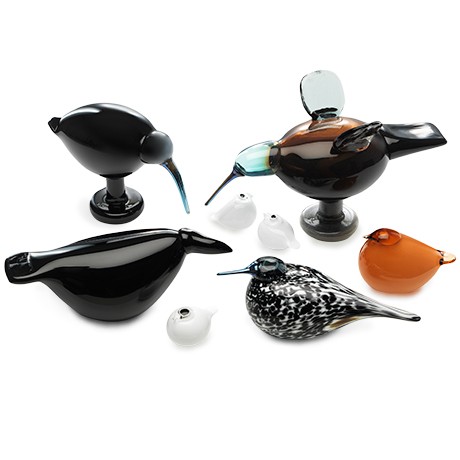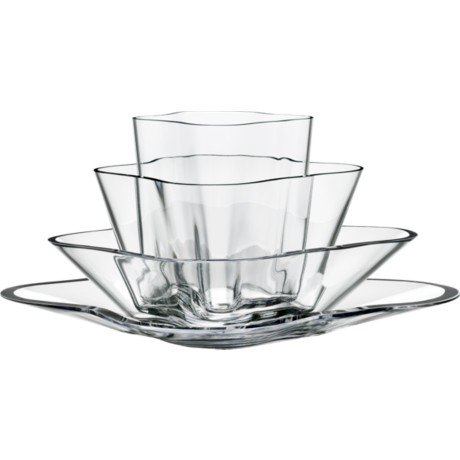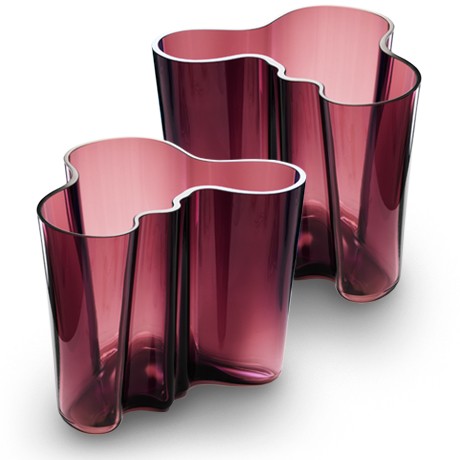iittala
Timeless design that will never be thrown away
Birds by Toikka
Oiva Toikka’s limitless imagination combined with his sophisticated knowledge of glass, has made it possible for him and Iittala glassblowers to create little miracles of life. Drawing from nature and his passion for art glass, Toikka has created more than 400 birds over the last forty years. Each bird is individually mouth-blown, making each one as unique as the person who collects it.
Alvar Aalto Collection
The Aalto vase dates back to 1936 and was first presented at the Paris World Fair the following year. Its fluid, organic form is still mouth blown today at the Iittala factory. It takes a team of seven skilled craftsmen working as one to create one Aalto vase – an icon of modern design.Alvar Aalto is undoubtedly one of thegreatest names in modern architectureand Scandinavian design.
Designers: Alvar Aalto
Teema
Highly versatile with endless combinations, Teema serves all your changing dining needs. You can prepare food with Teema dishes and use them in the oven. Teema can also be used for serving, storing and even freezing. Capturing essential design thinking, each object is derived from three basic forms: circle, square and rectangle. As Kaj Franck put it, “Colour is the only decoration needed”.
Designers: Heikki Orvola / Kaj Franck
Desingers
Göran Hongell (1902-1973),
was one of the pioneers of Finnish glass tradition. Hired by Karhula-Iittala in 1932 he went on to become the first permanent designer to be hired by a Finnish glassworks in 1940. To create his glass are he worked with glassblowers to develop special techniques and colour hues. His creations were simple and unadorned with a spirit of modernism combined with attenuated art deco.Designs for Iittala: Silko (1938); Maininki (1938); Säde (1939); Hongellin hattu (1941); Aarne (1948); Aulanko (1950’s).
Designs still in production at Iittala: Aarne (1948).
Awards: Aarne (1948): gold - Milan Triennale (1954).
Gunnel Nyman (1909-1948),
an internationally renowned Finnish designer known for her art glass and glassware sets, Nyman is considered a true pioneer who in the 1950’s laid the foundation of Finnish glass art. Nyman combined modern design with her free thinking and boldly transformed thick crystal with geometrical forms into clear lines and wavy patterns.Designs for Iittala: Ovaali (1946); Calla (1946); Muna (1947); Ylösnousemus (1947).
Awards: for her life’s work: Milan Triennale (1951 posthumously).
Lisa Johansson-Pape (1907-1989),
though she also designed furniture, was a lecturer and exhibition architect she was best known for her work in lighting and became the most significant Finnish lighting designer in the second half of the 1900’s.Designs for Iittala: Stella (1963); Viola (1963); Anemonie (1963); Achillea (1963); Chrysanthemum(1963).
Awards: Milan Triennale (1951); hanging lamp (1954): gold - Milan Triennale (1954); Order of the Lion of Finland (1957).
Aino Aalto (1894-1949),
designed buildings, interiors, furniture, and textiles. Some of Aino Aalto’s expansion into functionalism resulted in glass products that were simple, stackable and space saving. The design inspired by the rings made in water by a thrown rock, along with the multipurpose nature of the glasses made Bölgeblick an internationally renowned design classic. Aino Aalto also designed together with her husband Alvar Aalto.Designs for Iittala: Bölgeblick series (1932); Aalto tumbler (in collaboration with Alvar Aalto - 1933); Aalto Flower (in collaboration with Aino Aalto - 1939).
Designs still in production at Iittala: Bölgeblick, glasses, pitcher, plate - renamed Aino Aalto.
Awards: Exhibition architecture for Artek: Grand Prix - Milan Triennale (1936); Bölgeblick (1932): gold - Milan Triennale (1954).
Alvar Aalto (1898-1976),
a master of modern architecture, he designed, among other things, concert halls, libraries, hospitals and museums throughout the world. His unique style and exceptional talent can be seen in the diverse objects he has created, from furniture to a range of vases that culminated in his greatest design achievement the "Savoy" vase. This renowned work of art, as with many of his designs, has taken on a life of its own and was first seen at the 1937 Paris World Exposition. He and his wife Aino Aalto often collaborated in their design work.Designs for Iittala: Aalto tumbler (in collaboration with Aino Aalto - 1933); Aalto / Savoy bowl (1936); Savoy / Aalto vase (1936); Aalto / Savoy double (1936); Aalto Flower (in collaboration with Aino Aalto - 1939).
Designs still in production at Iittala: Aalto collection, bowl, votive, vase, flower set.
Tapio Wirkkala (1915-1985),
designed banknotes, graphic art, sculptures, furniture, jewellery and glass products. His versatility in design has produced more than 400 glassware’s and art glass pieces. Wirkkala had exceptional skills in glass making and his close collaboration with workers resulted in new techniques and lasting masterful design objects.Designs for Iittala: Finestra (1946); Pitsi (1947); Kantarelli (1951); Viinirypäle / Päärynä (1947); Kalvolan kanto (1948); Jääpala (1951); Jäävuori (1951); Tokio (1954); Tapio (1954); Marsalkansauva (1954); Rondo (1957); Romantica (1960); Paadrin (1960); Jäänsärkiä (1968).
Designs still in production at Iittala: Kantarelli (Chantarelle); Gaissa; Ultima Thule; Tapio.
Awards: Kantarelli, Viinirypäle / Päärynä, Varsanjalka, Kalvolan kanto, Tunturi, Jäkälä, Jääpala (1951); Jäävuori - Milan Triennale (1951); Tokio, Tapio, Marsalkansauva - Milan Triennale (1954); Tiima, Rondo - Milan Triennale (1957); Romantica (1960); Paadrin Jää - Milan Triennale (1960); Jäänsärkiä, Ultima Thule: bowl - Milan Triennale (1968); Lunning Prize (1951); Order of the Lion of Finland (1955); Prince Eugen Medal (1980).
Kaj Franck (1911-1989),
the conscience of Finnish design[40] would remove everything excessive so his designs would be left with only the essentials. Some of his most famous objects are the Teema tableware and the glass series Kartio.Designs for Iittala: "Kaivonkatsoja" (1946); Lakaisija (1946); Onkia (1946); Teema (Kilta) (1952); Kartio (1956); Tupa (1948).
Designs still in production at Iittala: Teema; Kartio; Purnukka; Ateenan aamu.
Awards: Milan Triennale (1951); Milan Triennale (1954); Milan Triennale (1957); Lunning Prize (1955); Order of the Lion of Finland (1957); Prince Eugen Medal (1964).
Valto Kokko (1933),
designed the i-VALO industrial lights series for Iittala and as a visual department manager in he was also involved in the advertising and marketing of his designs in 1963. Kokko created his first extensive glassware set Avec in 1973. His best known set Otso (Bonfire) is part of the collection of the Museum of Modern Art in New York. He also created two films "i-living" and "Vision in Glass".Designs for Iittala: Avec (1974); Otso (1978); Saana (1980); Sangria (1985); Pihla (1987); Marilyn (1988)
Awards: "i-living" (1979): Finnish industrial film of the year; "Vision in Glass" (1980): Finnish industrial film of the year.
Alfredo Häberli (1964),
is an international designer based in Zurich. Alfredo Häberli unites within his designs tradition with innovation, joy and energy.Designs for Iittala: Essence (2001); Kid's Stuff (2001); Senta (2003); Tris (2003); Origo (1999).
Designs still in production at Iittala: Essence; Senta; Origo.
Heikki Orvola (1943),
is a constant driving force within Finnish design. Orvola works with glass, ceramics, cast iron and textiles. In 1998 Orvola won the prestigious Kaj Franck prize.Designs for Iittala: "Aurora" (1972); Kivi (1987); Palazzo Pro Arte (1988); Verna goblet (1998); Verna vase (2004); Korento (2011).
Designs still in production at Iittala: Kivi; Korento; Aurora.
Awards: Kaj Franck Design Prize (1998); Order of the Lion of Finland (1984)
Timo Sarpaneva (1926 - 2006),
a master of materials such as glass, porcelain, cast iron and textile as well as graphic art. Saraneva's I-line became the Iittala trademark in 1956. Sarpaneva is one of the great personalities that is responsible for the reputation of Finnish design throught the world. His works can be found in international art and design museums and Orkidea has been described as the most beautiful object on earth.Designs for Iittala: Lansetti II (1952); Orkidea (1954); tumbler i (1956); Tsaikka (1957); stackable bottle (1959); sarpaneva (1960); Festivo (1966); Claritas (1984).
Designs still in production at Iittala: Tsaikka; Orkidea; Claritas; Festivo; sarpaneva; Steel plate.
Awards: I-line (1954); Lunning Prize (1956); Order of the Lion of Finland (1958); Honarary Doctorate: Aalto University (1993)
Oiva Toikka (1931),
is one of the greatest names in Finnish glass and best known for his "Birds" collection. His works resound in imaginative, rich, bold and streamlined aesthetic Nordic design. His Birds collection has so far produced 400 glass art objects and Kastelhelmi selection and range enjoys great success.Designs for Iittala: Kastelhelmi (1964)Flora (1966); Birds (1971); Annual Cube (1977); Niili (1989); Delta (1989); Vaskooli (1988); Full Moon (1989).
Designs still in production at Iittala: Birds; Annual Cube; Kastelhelmi.
Awards: Lunning Prize (1970); Order of the Lion of Finland (1980); World Glass Now 85 (YEAR); Kaj Franck Design Prize (1992); Prince Eugen Medal (2001).
Company history
In April 1881, in the southern province of Finland, in the town of Iittala the Swede, Petrus Magnus Abrahamsson, after having left the Nuutajärvi glassworks, founded the Iittala Glasbruks Aktiebolag. Due to the lack of skilled glassblowers in Finland the first 17 glassblowers came from the Limmared glassworks in Sweden. They along with the local Swedish glassblower Johan Fredrik Gauffin, who was part owner, made the first glass objects on November 24th 1881.
In February 1888 Abrahamsson left the loss-making Iittala glassworks and Anders Andersson the chairman of the board took over the directorship of the Iittala glassworks. In 1865 the Swede, Anders Norstedt resigned as administrator from the Nuutajärvi glassworks and moved to Helsinki to handle his business interests. By 1895 Anders Norstedt was the majority shareholder of the Iittala Glasbruks Aktiebolag.
Claës Norstedt, the son of Anders Norstedt started at the Iittala glassworks in autumn 1895 as a clerk. Later he became the factory manager and in spring 1896 after his father’s death Claës Norstedt was promoted to deputy director. Claës Norstedt was highly qualified and is the first Finnish professional in the field of glass but he was content just managing and supervising technical aspects at the glassworks, so he travelled throughout Finland on many commercial business trips. It was during his tenure that the Iittala glassworks enjoyed its first boom.
 |
| Savoy-maljakko, 1936 |
An initiative by Norstedt resulted in Iittala’s iron mould foreman, Alfred Gustafsson becoming the first in-house designer at Iittala glassworks. In 1903 Gustafsson created the glass series Great Men to passively protest Russian rule.
In 1917 due to the First World War raw materials began to become difficult to obtain, inflation caused prices to rise and wages soared resulting in Norstedt giving up the Iittala glassworks. Karhula Oy, part of the A. Ahlström Group (a timber refinery) bought the Iittala glassworks and Norstedt resigned from the board in March 1917.
Up until 1910 – 1920 Iittala glassworks produced glass wares using imported moulds resulting in products being very similar within Finland and abroad.
In time the entire ownership of Iittala stock went to the Ahlström Group. Though Iittala no longer existed as an independent company, Iittala continued to have a separate corporate identity until 1935 when the Iittalan Lasitehdas Osakeyhtiö was formed with the Karhula Company. From then on products were produced under Karhula-Iittala.
In 1932 Göran Hongell, was hired by Karhula-Iittala and became the first designer hired for a Finnish glassworks. Hongell initiated collaboration between designers and glassblowers by bringing drawings to the glass workshop to ask about technical aspects of blowing the object.
At the Karhula-Iittala design competition in 1932 Aino Aalto’s famous Bölgeblick won second place. Bölgeblick tumblers went into mass production in 1949. They were discontinued in 1960 but production restarted at the Karhula glassworks in 1983. Since 1994 the Iittala glassworks took over the production where they are still being made to this day.
With demand for bottles and glasses increasing since 1932 Hans Ahlström from the Ahlström Group started to modernize the Karhula and Iittala glassworks in 1935.
Ahlström officially divided the production of Karhula-Iittala products in 1937. Iittala glassworks would concentrate on hand-blown glass while Karhula glassworks would take over all automated glass production. The plans which had been around as early as 1933 were delayed because of WW2, though working methods and furnaces’ were modernized anyways in 1937. Some of the changes at the Iittala glassworks included the conversion of a single special crucible furnace and the old 4 crucible furnace into 6 crucibles. An 8 crucible regenerative furnace was also built but the substantially increased output did not change the fact that all exported Iittala products were still sold under the Karhula brand and within Finland Iittala products were still sold under Karhula-Iittala. After the taking over of the Viiala glassworks by Karhula Oy and Riihimäen Lasi Oy a separate furnace for blowing electric lamps was built, since the employees, as part of the deal went to the Iittala glassworks.
During the Winter War and the Continuation War, part of the Second World War, production came to a halt due to shortages of materials and workforce. Production restarted in 1946 and factory modernization was continued by Antero Järvinen and in 1947 a new gas centre and compressed air system was built. The special single crucible furnace was converted into a day tub and the 6 crucible was upgraded to 8 crucibles. Flame cutting was introduced, allowing for cleaner cuts than the cracking method. Järvinen also started to push an agenda to make design more prominent within the Iittala glassworks. This was continued when Håkan Södermaström became the administrator in 1950 and further pushed the Iittala glassworks to apply design to the entire range of products.
With much of Ittala’s production being lamp glass for the international market Valto Kokko was hired in 1963. He was not only responsible for designing lamp glass and printed matter but he was also involved in advertising and exhibitions. Though lamp glass manufacturing profits were shrinking, a separate lamp glass factory was built in 1971. The new factory was used to produce lights for homes and public facilities. Industrial lights were first produced in 1975 for Ahlströms Varkaus paper mill.
Sales of their products in Finland were also continuously under competition from the ever growing import of foreign glassware but Iittala enjoyed continued success until the oil crisis of the mid-1970s, when it had to cut back on its operations. In 1981 Iittala was Finland’s largest exporter of glass accounting for 77% of exports. In 1983 Iittala glassworks had 530 employees. Glass manufacturing was relocated to another Ahlström business unit in 1985, since Iittala was now focused mainly on exports.
In 1988 the owners of the Iittala glassworks, A, Ahlström Corporation and Wärtsilä, the owners of Nuutajärven Lasi, the Humppila glassworks and Napapiirin Lasi merged into Iittala-Nuutajärvi Oy. A, Ahlström retained 70% of the shares and Wärtsilä 30%. Product collections stayed the same but the brand name Iittala was used for exports.
 In 1990 Iittala-Nuutajärvi Oy was sold to the Hackmann Group who had obtained Arabia and Rörstrand-Gustavsberg. The Designor business area of the Hackman Group was renamed to Iittala oy ab in 2003.
In 1990 Iittala-Nuutajärvi Oy was sold to the Hackmann Group who had obtained Arabia and Rörstrand-Gustavsberg. The Designor business area of the Hackman Group was renamed to Iittala oy ab in 2003.
In 2004 the Italian ALI Group bought the Hackman Group and sold the business area Iittala oy ab to the Iittala management and the international private equity investment company ABN AMRO Capital.
In 2007 Iittala was bought by Fiskars and is now, a group within the Fiskars Corporation. The operative management of Iittala holds 3 percent of the shares.
Structurally the Iittala Group has been merged into Fiskars Corporation and within the main 3 division of Fiskars are Home, Garden and Outdoor.
Subscribe to:
Comments (Atom)



